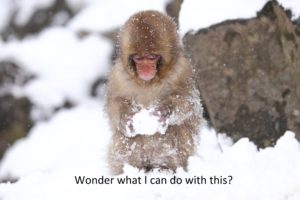
There are two realities. There’s the way things are, and then there is the way we would like them to be. We are all the star in our own show of life, but it is sobering to reflect that we have small supporting roles in all the lives around us. We would like to be the center of the universe, so we made a whole mythology to support this. God made man in His image, put the earth at the center of the universe and gave us the animals to name, making us godlike. For centuries science has been removing one bastion of specialness after another – not without resistance. First the earth wasn’t the center of the universe, then the sun wasn’t the center, then there wasn’t any center at all. At least we were still God’s special creatures.
Then along came Darwin. At least we were still way different from the other creatures – still special, and a whole cottage industry sprang up to catalogue our specialness. We’re the only one with opposable thumbs, we play, we use tools, and we have language. We are intelligent and they are not. We have subways and they don’t. There were problems with this line of reasoning. We kept finding exceptions to the rules, then like falling back in a war we would redefine the rules only to find more exceptions. Then along came Jane Goodall.
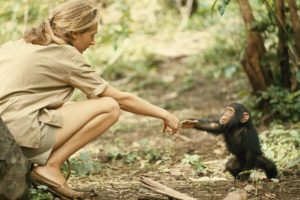
There seems to be an insecurity that if animals are raised up we are diminished in some way. I disagree. I think we are diminished if we hold to a false reality. Intelligence for me needs two ingredients:
1) Curiosity 
2) Sense of humor 
A lot of people are not intelligent by those measures.
Jane Goodall was the first one to study animals on their own turf and their own terms. She observed them using tools, like twigs to get out ants. Any animal that can use a tool is thinking in the abstract. Even crocodiles do it. They will take a twig and submerge leaving the twig above the water. A bird tries to grab the twig for a nest and the crocodile grabs the bird. They only do this during nesting season, knowing that it is a waste of time otherwise. They are inverted fishermen. Crocodiles will observe the bird’s behavior and plan accordingly.
One day a young chimpanzee was not feeling well and was trailing behind the tribe. It was teething. The mother went to a willow tree and pulled the bark off, giving it to the baby. Salicylic acid, the active ingredient in aspirin, comes from the willow. Chimpanzees know pharmacology. This is not an isolated example. Scientists have observed primates using many kinds of herbal compounds including antibiotics and intoxicants. They also know how to use them. Some leaves are chewed, some not, some are picked at specific times. They also have cultures. Different groups know about different kinds of drugs and tools. This information is probably handed down.
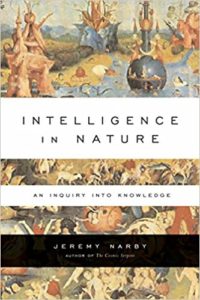
These examples of animal intelligence are explored in Intelligence in Nature, a surprising and thought provoking book by Jeremy Narby. For example, you’ll never think of the term “birdbrain” the same way again. Birds such as crows display what psychologists call, “Theory of Mind” where a bird can get into another bird’s head and figure out (in the case of crows) how to deceive it. Crows are all great thieves. Crow A has a nut. He hides it while Crow B is watching then moves away from it, ignoring it until crow B goes away. Then he moves the nut to a different hiding place. In another example there are birds on the ground feeding, therefore vulnerable. They post a few sentinel birds on branches to watch for predators. If a predator comes the sentinels make a particular call and all the birds take off. But other birds can learn that call too. They make the call and clear all the other birds off to feed unmolested. A typical grey parrot from a pet shop was taught a vocabulary of over 1000 words. He knew what the words meant. He could pick out objects and colors by name, and distinguish the numbers one to six. When he had had enough work in the lab he would say “No,” and turn his back on the researcher. If you’re not looking for something you won’ find it. People assume parrots are just “parroting,” missing a chance at a much deeper relationship. It makes one wonder about parrots that tell dirty jokes. “Did you hear the one about the primate taking a selfie?”
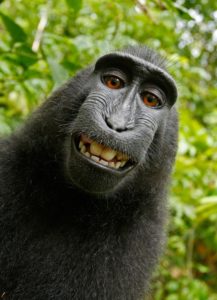
Lest you think there is no intelligence in plants, the acanthus tree is a favorite food of giraffes. When giraffes start to feed it secretes toxins into its leaves to stop them. It also releases pheromones into the air which warn all the other acanthus trees that the giraffes are at it again. The trees that get the message pump toxins into their leaves proactively. The giraffes display their intelligence by going to new trees that are upwind of the original tree and therefore uninformed of the danger.
One of the most intriguing and disquieting examples of plant intelligence is of a parasitic plant called dodder that can walk – sort of. The parasite smells its way to vegetation that is wants to prey on, sending shoots in that direction. It will wrap a feeler around its victim, gauge the plant’s health, and only wrap its other tendrils around the victim if it is healthy enough to make it worthwhile. If the plant is sickly, dodder moves on, letting older parts of itself die off.
Plants don’t have brains, they just act that way. How can that be? Since we think with our brains, it is hard for us to imagine other structures that would do this, but in other life forms we see learning, teaching, language, planning, deception, intent, culture, grieving, cooperative hunting, and play.
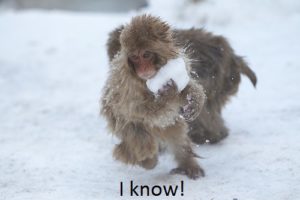
Play is a great example of intelligence. It is an activity that has more to do with delight then survival. Dolphins don’t have hands but they make do by grabbing fronds of seaweed on their fins and swimming past other dolphins who try to intercept them, like football. As you might expect, killer whales have a blood sport. They will take some penguin that they have already injured and toss it back and forth over the water, playing catch. Sea lions do the same thing with the hapless sunfish. Some people read a purpose into this like increasing hunting skills, but the more obvious reason is that the exercise of power is enjoyable, just ask a cat with a mouse – or a schoolyard bully.
Whales may also have language, we just don’t know what they are saying. Each whale has songs unique to that creature, and they like to spread their song around. The ocean is like a layer cake, with different depths having different temperature and densities. Sound made in one layer tends to be trapped there so the sound travels horizontally in that layer for hundreds, maybe thousands of miles. It’s like a party line for whales. When they feel like talking, they dive down to a deep layer of the ocean and sing to each other. Whales may also have names. Pods of killer whales have call signs unique to that pod, and they add a call sign unique to that whale, like a first name and last name. Killer whales in captivity imitate the language of the lesser dolphins. Are they trying to communicate with them? Humpbacks do. The gregarious humpback whale has been observed approaching whales of other species and imitating their song. Humpbacks have also been observed working together to protect themselves and even other species from killer whales.
As I began researching animal and plant intelligence I found myself gorging on the huge selection of scientific papers on this extensive and rapidly expanding topic. The examples seem to be as common as life itself. If you like to stretch your mind to encompass a greater, richer world, find a hammock and plunge into Intelligence in Nature. Maybe your dog will even read it to you.


I love this topic, thanks for posting. Jane Goodall has been a personal hero of mine since I was a kid. She has the life I’d have wanted if I’d been willing to sit still in a jungle for hours at a time. As it is, I’ve settled for what wildlife has been available in the city and suburbs of the northeastern U.S. Wondered if you’ve seen this mind-boggling TED talk on the social lives of trees. https://www.ted.com/talks/suzanne_simard_how_trees_talk_to_each_other
I’ll watch it tonight. There is also a great book called The Hidden Life of Trees by Peter Wohlleben.